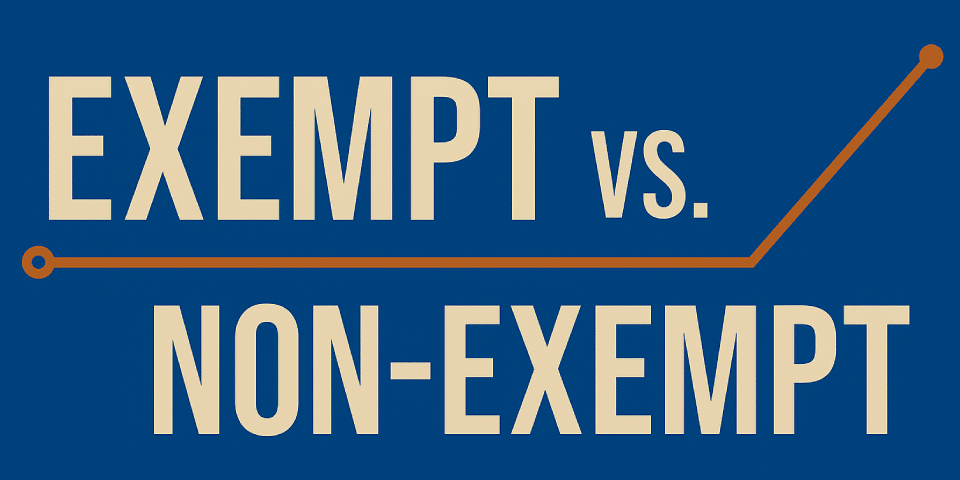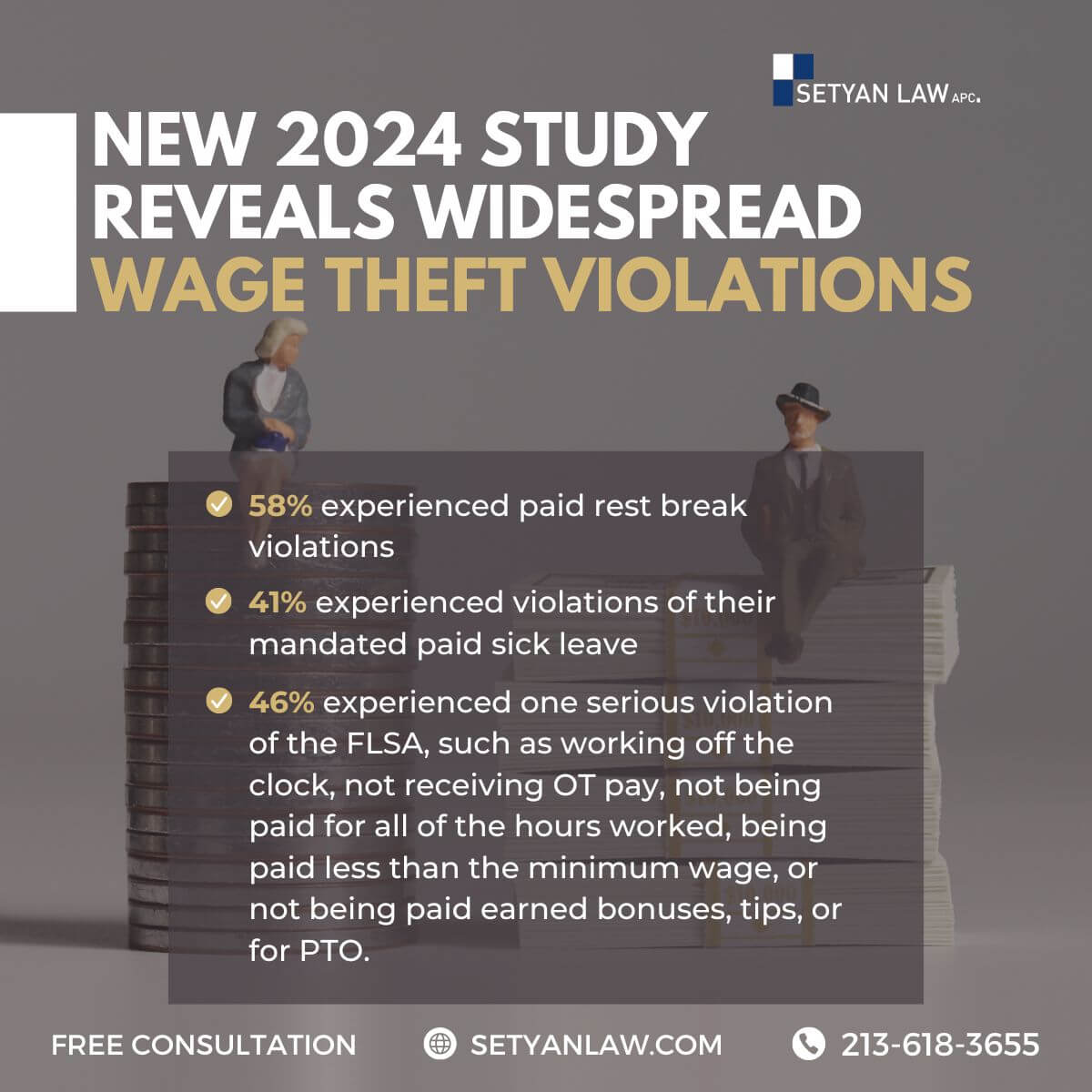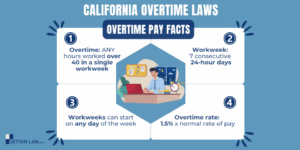Updated August 21, 2025
Exempt vs Non-Exempt Employees [2025 Guide]
When it comes to your paycheck, the difference between exempt vs non-exempt status can mean thousands of dollars in your bank account each year. Many employees don't realize how significantly this classification affects their overtime pay, work schedule flexibility, and overall compensation structure. While exempt employees receive a consistent salary regardless of hours worked, non-exempt workers are entitled to overtime pay for any hours beyond 40 in a workweek. Importantly, these classifications aren't optional or arbitrary—they're legally defined under the Fair Labor Standards Act (FLSA) and have specific criteria that must be met. With the Department of Labor's updated salary thresholds coming in 2025, understanding your correct classification has never been more critical. In this guide, we'll break down exactly what these classifications mean, how they impact your paycheck, and what you can do if you believe you've been wrongly classified.
Exempt vs Non-Exempt: What Do These Terms Mean?
The Fair Labor Standards Act (FLSA) creates two distinct employee classifications that determine how workers are paid and protected. These classifications—exempt and non-exempt—form the legal foundation for wage regulations across the United States.
Definition of Exempt Employees Under FLSA
Exempt employees are workers who are not entitled to overtime pay and are "exempt" from certain FLSA provisions. To qualify for exempt status, employees must pass three specific tests:
First, they must receive payment on a salary basis rather than hourly. This means they receive a predetermined amount each pay period that cannot be reduced based on the quality or quantity of work performed.
Second, they must meet the salary level test by earning at least $684 per week ($35,568 annually) [1]. This threshold was established on January 1, 2020, replacing the previous requirement of $455 weekly [1].
Third, they must pass the duties test by primarily performing work that falls into one of these categories:
- Executive: Regularly supervising two or more full-time employees with management as their primary duty and input into employment decisions [2]
- Administrative: Performing office or non-manual work related to business operations or management with independent judgment [2]
- Professional: Using advanced knowledge in fields requiring specialized instruction and consistent exercise of judgment [2]
Job titles alone do not determine exempt status—actual job duties and meeting all three tests are what matter [3].
Definition of Non-Exempt Employees Under FLSA
Non-exempt employees are workers entitled to minimum wage and overtime protection under the FLSA. The term "non-exempt" indicates these employees are not exempt from the Act's wage and hour provisions.
The primary characteristic of non-exempt status is overtime eligibility. These employees must receive overtime pay at a rate of at least one and one-half times their regular pay rate for all hours worked beyond 40 in a workweek [4]. Furthermore, non-exempt workers must earn at least the federal minimum wage of $7.25 per hour [4].
Although non-exempt employees are typically paid hourly, they can also receive salaries. In fact, "salaried non-exempt" is a legitimate classification for employees who receive a fixed salary but remain eligible for overtime pay [1].
Common non-exempt positions include retail associates, customer service representatives, construction workers, and clerical staff [5].
Key Legal Distinctions Between the Two
The most fundamental difference between these classifications is overtime eligibility. Non-exempt employees must receive overtime compensation, whereas exempt employees are not legally entitled to additional pay regardless of how many hours they work [6].
Another key distinction involves consistency of income. Exempt employees generally receive the same salary regardless of hours worked, providing stable income. In contrast, non-exempt employees may experience variable pay depending on their hours.
The FLSA provides different protections for each classification. Non-exempt employees receive stronger wage protections, including guaranteed minimum wage and overtime. Meanwhile, exempt positions typically offer more autonomy and professional discretion.
It's important to note that "blue-collar" workers performing manual labor are generally non-exempt regardless of their salary. This includes carpenters, electricians, mechanics, plumbers, and construction workers [3].
Misclassification—incorrectly designating employees as exempt when they should be non-exempt—can result in significant legal and financial consequences for employers, including fines and back pay obligations [6].
How Classification Affects Your Paycheck
The financial implications of your employee classification reach far beyond a simple label. Your exempt or non-exempt status directly impacts how much money you earn, when you receive it, and whether additional hours translate to additional pay.
Salary vs Hourly Pay Structures
Exempt and non-exempt classifications typically correlate with different payment methods. Exempt employees generally receive a salary—a fixed amount paid regardless of hours worked. According to FLSA regulations, to qualify for exempt status, employees must earn at least $684 per week or $35,568 annually [7]. This fixed wage is typically distributed biweekly or monthly in equal installments [8].
Conversely, non-exempt employees are more commonly paid hourly, calculating compensation based on precise time worked. Their pay fluctuates depending on actual hours completed each pay period. For instance, someone earning $25 per hour might receive $1,000 for a 40-hour week but only $700 if they work 28 hours the following week [9]. Nevertheless, it's important to understand that some non-exempt employees can receive salaries as well, provided they still receive overtime when applicable.
Overtime Eligibility: Who Gets Paid Extra?
Perhaps the most significant paycheck distinction between classifications centers on overtime compensation. Non-exempt employees must receive overtime pay at a rate of at least one and one-half times their regular rate for all hours worked beyond 40 in a workweek [7].
Consider this practical example: A non-exempt employee earning $25 per hour who works 45 hours in a week would receive:
- $1,000 for the first 40 hours ($25 × 40)
- $187.50 for the 5 overtime hours ($37.50 × 5)
- Total weekly earnings: $1,187.50 [8]
In contrast, exempt employees receive no additional compensation regardless of extra hours worked. An exempt manager earning $75,000 annually would receive approximately $6,250 monthly whether they work 40, 50, or 60 hours weekly [8]. Subsequently, this can substantially impact total compensation when consistent overtime is involved.
The FLSA expressly prohibits averaging hours across multiple workweeks—each 168-hour period (seven consecutive 24-hour days) stands alone for overtime calculation purposes [10]. Additionally, contrary to common misconception, the FLSA doesn't mandate extra pay for weekend or holiday work unless those hours push the employee beyond 40 weekly hours [10].
Consistency of Income: Fixed vs Variable Pay
Exempt and non-exempt statuses create fundamentally different income experiences. Exempt employees enjoy predictable, consistent income that remains stable regardless of minor fluctuations in hours worked. This predictability facilitates long-term financial planning and budgeting [11].
Non-exempt employees, however, often experience variable pay dependent on hours worked. This creates potential for higher earnings through overtime but introduces financial uncertainty when hours are reduced [8]. During business slowdowns, hourly workers typically feel the impact first as employers can more easily reduce their hours compared to eliminating entire salaried positions [11].
Beyond base compensation, classification often influences benefit structures. Salaried positions typically include benefits like paid vacation, sick leave, and healthcare coverage [11]. Hourly positions may offer fewer benefits, potentially requiring employees to secure their own health insurance or forego paid time off [11]. This difference in total compensation package can significantly impact overall financial well-being beyond the numbers on a paycheck.
Understanding how your classification affects your paycheck empowers you to make informed career decisions and properly evaluate compensation offers beyond just the headline salary or hourly rate figure.
The Three Tests for Employee Classification
Understanding employee classification under the FLSA requires employers to apply three distinct tests that determine whether a worker qualifies as exempt. Each test serves a specific purpose in ensuring proper classification, namely the Salary Basis Test, Salary Level Test, and Duties Test.
Salary Basis Test: Fixed Weekly Pay Requirement
The Salary Basis Test establishes that exempt employees must receive a predetermined amount of compensation on a weekly or less frequent basis [12]. This fixed payment cannot be reduced due to variations in work quality or quantity. Essentially, if an employer deducts from an employee's predetermined salary because of business operating requirements, that employee fails the test [13].
For an employee to pass this test, they must receive their full salary for any week in which they perform work, regardless of days or hours worked [12]. When an employee is ready and willing to work, deductions cannot be made for times when work is unavailable [13]. Moreover, employers can use nondiscretionary bonuses and incentive payments (including commissions) to satisfy up to 10% of the standard salary level, provided these payments occur at least annually [12].
Salary Level Test: 2025 Thresholds and Updates
The Department of Labor recently updated the minimum salary thresholds for exempt status. Currently, employees must earn at least $684 per week ($35,568 annually) to qualify for exemption [14]. Primarily, this will change through a two-phase implementation:
- Beginning July 1, 2024: The threshold increases to $844 weekly ($43,888 annually) [14]
- Beginning January 1, 2025: The threshold rises to $1,128 weekly ($58,656 annually) [14]
Similarly, the total annual compensation requirement for highly compensated employees will increase from $107,432 to $132,964 on July 1, 2024, and further to $151,164 by January 1, 2025 [14]. These thresholds don't apply to certain professionals, specifically teachers, doctors, lawyers, and outside sales employees [14].
Duties Test: Executive, Administrative, and Professional Roles
The Duties Test examines the actual job functions performed, regardless of job title. To qualify under the executive exemption, an employee must manage a company or department, regularly direct at least two full-time employees, and have authority in hiring, firing, and advancement decisions [15].
For the administrative exemption, an employee's primary duties must involve office or non-manual work directly related to management or business operations, plus exercise discretion and independent judgment on significant matters [15]. The professional exemption requires work demanding advanced knowledge in a field of science or learning, acquired through specialized instruction [15].
Computer professionals constitute another exempt category, requiring work in systems analysis, programming, or software engineering [15]. Undeniably, job titles alone never determine exempt status—actual job functions are what matter [4].
Passing just one or two tests is insufficient—all three tests must be satisfied simultaneously for an employee to be properly classified as exempt from overtime requirements [4]. Consequently, even highly-paid employees performing non-exempt duties remain entitled to overtime protection, emphasizing the importance of understanding these classification standards.
Real-World Examples of Exempt and Non-Exempt Roles
Job titles can illustrate the practical application of exempt vs non-exempt classification. Though titles alone don't determine status, certain positions typically fall into specific categories based on their duties and compensation structure.
Common Exempt Jobs: Managers, Engineers, Teachers
Looking at the workplace landscape, exempt positions primarily involve roles requiring specialized education, independent judgment, or management responsibilities. Business executives, accountants, and marketing professionals commonly qualify for exempt status [1].
Specifically, management positions supervising two or more full-time employees typically meet exemption criteria. Beyond supervision, executive assistants with authority to make significant decisions on behalf of senior leadership often qualify as exempt [1].
Professional roles with advanced education requirements typically fall into the exempt category, including:
- Doctors and lawyers
- Teachers and professors
- Engineers and architects
- Registered nurses (in some states)
- Software engineers and computer systems analysts [1]
Common Non-Exempt Jobs: Retail, Construction, Clerical
Non-exempt positions typically center around repetitive or routine tasks with limited independent decision-making. Construction and maintenance workers, including electricians and carpenters in non-management positions, almost always qualify as non-exempt [1].
Likewise, most retail positions (particularly cashiers), clerical roles with limited autonomy, and quality assurance workers following preset guidelines typically receive non-exempt classification [1]. Other common non-exempt positions include:
- Licensed practical nurses
- Food servers
- Mechanics
- Bookkeepers and accounting clerks
- Receptionists and administrative assistants [1]
The FLSA explicitly states that "blue-collar" workers performing manual labor are generally non-exempt regardless of their salary level [7].
Hybrid Roles and Gray Areas
Certain positions span multiple functional areas, creating classification challenges. These hybrid roles may handle responsibilities across HR, budget, payroll, and facilities management [3].
To classify these positions properly, employers must determine which duties constitute the majority of the role. If one set of duties makes up over 50% of the job, that function typically determines classification [3].
For "working supervisors" who both manage and perform non-supervisory duties, classification depends on the percentage of time spent supervising others [3]. This becomes particularly important in industries like transportation, where contractor status vs. employee classification creates additional complexity [6].
Risks of Misclassification and Legal Consequences
Misclassifying workers as exempt or non-exempt carries serious legal and financial repercussions for employers. Even unintentional errors can result in significant penalties and ongoing consequences that extend beyond initial fines.
Penalties for Employers: Fines and Back Pay
Employers face steep financial penalties for incorrectly classifying employees. The IRS may impose charges of up to 3% of misclassified employees' wages, 100% of unpaid FICA taxes, and up to 40% of FICA taxes that should have been withheld [16]. For willful violations, California employers can face civil penalties between $10,000 and $25,000 per misclassified employee [16]. In other states, first-time audit penalties reach $1,000 per misclassified individual, escalating to $5,000 for third or subsequent violations [17].
Beyond fines, employers must pay back wages for overtime violations. Under the Fair Labor Standards Act, employers may be required to provide back pay for up to two years, extended to three years for willful violations [18]. This includes all unpaid overtime, minimum wage deficits, and in some cases, liquidated damages equal to the amount of back wages owed [19].
Employee Rights and Legal Recourse
Misclassified employees lose access to crucial protections, including minimum wage guarantees, overtime pay, family and medical leave, and anti-discrimination safeguards [20]. Indeed, they're often denied unemployment insurance, workers' compensation, and employer contributions to Social Security and Medicare taxes [20].
Workers suspecting misclassification can file complaints with several agencies. They may contact state departments of revenue and labor, the U.S. Department of Labor Wage and Hour Division, or file Form SS-8 with the IRS for a work status determination [21]. Misclassified workers can also file for unemployment benefits despite contractor status, as state agencies make independent determinations [22].
How to Correct a Misclassification
Employers should rectify misclassification promptly upon discovery. Initially, review worker classifications based on job duties, degree of control, and contractual arrangements [5]. After identifying issues, consult employment attorneys or tax specialists familiar with classification regulations [2].
Some jurisdictions offer voluntary disclosure programs. In the U.S., the Voluntary Classification Settlement Program allows employers to reclassify contractors while paying only 10% of employment taxes that would have been due for the previous tax year [23]. Finally, organizations must update contracts, notify affected workers, and pay all required back wages and taxes to relevant authorities [2].
Conclusion
Understanding Your Classification: The Bottom Line
The distinction between exempt and non-exempt status represents far more than a technical classification. This designation fundamentally shapes your compensation, overtime eligibility, and workplace rights under federal law.
Throughout this guide, we've examined the crucial differences between these classifications. Non-exempt employees benefit from FLSA protections including guaranteed minimum wage and time-and-a-half overtime pay for hours worked beyond 40 in a workweek. Exempt employees, while forgoing overtime eligibility, typically enjoy more consistent income and potentially greater workplace autonomy.
Employers must apply three essential tests to properly classify workers: the Salary Basis Test requiring fixed weekly pay, the Salary Level Test with updated 2025 thresholds, and the Duties Test examining actual job functions rather than titles. Additionally, significant changes loom on the horizon with the Department of Labor's new salary thresholds—$43,888 annually starting July 2024 and rising to $58,656 by January 2025.
Job titles alone never determine classification status. Actual responsibilities matter most, which explains why professionals like engineers and teachers typically qualify as exempt while retail associates and clerical workers generally remain non-exempt. Consequently, "hybrid" positions require careful analysis to determine proper classification.
The stakes remain high for employers who misclassify workers. Substantial financial penalties, back pay obligations, and potential legal action await those who incorrectly designate employees. Workers suspecting misclassification have multiple avenues for recourse through state labor departments, the federal Department of Labor, or direct IRS intervention.
Your employment classification directly affects your financial well-being. Armed with this knowledge, you can better advocate for your workplace rights, understand your compensation structure, and ensure your employer has classified you correctly under federal law. After all, when it comes to your paycheck, knowing the difference between exempt and non-exempt status proves essential for protecting your hard-earned money.
References
[1] – https://www.paychex.com/articles/payroll-taxes/whats-the-difference-between-exempt-and-non-exempt-employees
[2] – https://velocityglobal.com/resources/blog/employee-independent-contractor-misclassification-guide/
[3] – https://hr.berkeley.edu/hr-network/central-guide-managing-hr/managing-hr/recruiting-staff/classification/hybrid-jobs
[4] – https://peoplespheres.com/exempt-employees-how-to-classify-them-correctly/
[5] – https://www.getontop.com/blog/how-to-correct-employee-misclassification
[6] – https://www.ccjdigital.com/business/article/14940027/dol-rule-would-stamp-out-gray-areas-in-driver-classification
[7] – https://www.dol.gov/agencies/whd/fact-sheets/17a-overtime
[8] – https://onpay.com/insights/salary-vs-hourly-pay-guide/
[9] – https://www.atsinc.com/blog/careers/salary-vs-hourly-pay-structures-exempt-non-exempt-compensation-explained
[10] – https://www.dol.gov/agencies/whd/overtime
[11] – https://www.investopedia.com/articles/personal-finance/031115/salary-vs-hourly-how-benefits-laws-differ.asp
[12] – https://www.dol.gov/agencies/whd/fact-sheets/17g-overtime-salary
[13] – https://www.law.cornell.edu/cfr/text/29/541.602
[14] – https://www.dol.gov/agencies/whd/overtime/salary-levels
[15] – https://www.bamboohr.com/resources/hr-glossary/duties-test
[16] – https://www.deel.com/blog/employee-misclassification-penalties/
[17] – https://www.tax.virginia.gov/worker-misclassification
[18] – https://www.dol.gov/general/topic/wages/backpay
[19] – https://www.darrow.ai/resources/penalties-for-misclassifying-employees-as-independent-contractors
[20] – https://www.dol.gov/agencies/whd/flsa/misclassification/myths/detail
[21] – https://www.dpeaflcio.org/factsheets/recourse-for-employees-misclassified-as-independent-contractors
[22] – https://www.nolo.com/legal-encyclopedia/what-should-you-do-if-youve-been-misclassified-independent-contractor.html
[23] – https://www.omnipresent.com/articles/how-to-correct-employee-misclassification
Call Setyan Law at (213)-618-3655 to schedule a free consultation.






